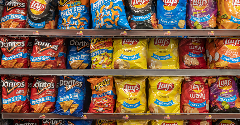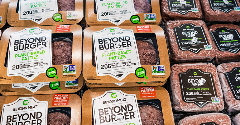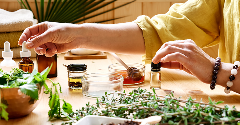News
Lycored declares natural colourings "super stable"
26 Jul 2018A new batch of carotenoid-derived colours from Lycored has proved to be “super-stable” in hard coated candy and vitamin-enriched gummies, the company reports.

A new batch of carotenoid-derived colours from Lycored has proved to be “super-stable” in hard coated candy and vitamin-enriched gummies, the company reports. Research has, it says, shown that the use of natural colours does not diminish the appeal of candy to children and actually enhances it for parents.
Lycored’s Tomat-O-Red (pinks to reds) is sourced from lycopene from tomatoes, while Lyc-O-Beta (yellows and oranges) is extracted from beta-carotene.Initially, tests were carried out to check the performance of these carotenoid-derived colours in vitamin-enriched gummies. This included accelerated and real-time shelf-life stability on gummies coloured with six different Lycored shades. They were compared with samples produced by the same manufacturer but coloured artificially. The Lycored-colored gummies contained vitamin C, but the artificially coloured alternatives did not. The natural colours from Lycored all remained true to fruit in their natural colour hues and their stability was strong under intense light conditions, according to the company, and similar to that of the synthetic colours. This was the case despite the additional stress of vitamin C content, which disrupts the stability of some colorants.Lycored also looked into the performance of its carotenoid-derived colours during the rigorous hard-coating, panning process in hard-coated confectionery. The solutions were tested in two different coatings for candy – Quick White from Norevo and titanium dioxide.The formulations, in shades of red, yellow and orange, were tested for four weeks at temperatures of 20°C, 25°C, 30°C, and 35°C in clear plastic bags and in a humidity-controlled environment.The investigation showed that all colours performed very well with good quality shades in both coatings. Christof Ruttgers, Confectionery Technologist at D&F Drouven, who carried out the research, remarks on their user-friendliness compared to other colour sources. “Water-soluble reds can be challenging to work within confectionery as they often become white or dusty when sugar crystals form,” he says. “This is the case with synthetics and maltodextrin-based colors, as well as vegetable, concentrates such as beets.”“However the Lycored colours we tested are oil-based, which makes them much more resilient.”Lycored’s consumer research also revealed that natural colours are not a deal-breaker for children. The company wanted to get some insights into how children and their parents perceive colour in candies. Interviews with ten children and their parents were conducted with each pair being sent a bag of gummies coloured naturally with Tomat-O-Red and Lyc-O-Beta and another made by the same manufacturer but coloured artificially.Both the children and their parents were able to distinguish between the naturally coloured candies and the artificial ones. However, although the children tended to prefer the brighter, artificial colours, they were enthusiastic about eating all of them, says Lycored. The parents said that ideally, they would prefer to feed their kids healthy options and if all other factors, such as taste, were similar they would buy candy-coloured naturally. Some said they would be willing to pay more for naturally coloured versions of candy they already buy.“For kids, candy is candy and taste is king. They might notice that artificially coloured products look brighter, but colour definitely isn’t a deal-breaker. And when their parents realize that naturally coloured products taste exactly the same, factors like clean label and naturality come back into play,” said Christiane Lippert, Head of Marketing, Food, at Lycored.“Meanwhile, we’re delighted that two more stability trials have demonstrated the high performance of our natural colors in yet another category.”Related news

PepsiCo formulates ‘naked’ Cheetos and Doritos products
31 Dec 2025
US food giant PepsiCo has launched its Simply NKD range, a move it says reimagines its popular products with new formulations free from artificial flavours, dyes, and colours.
Read more
Debate over ban on ‘meaty’ names for plant-based products reaches stalemate
26 Dec 2025
The debate over a ban on plant-based products using “meaty” terms has reached a stalemate, leaving manufacturers in limbo and still facing overhauls to their marketing and packaging.
Read more
Has ‘clean’ had its day?
22 Dec 2025
Wielding clean-label positioning and fortification as marketing levers is a dangerous strategy, and brands would be better off explaining the hows and whys of the ingredients in their products, say experts.
Read more
Bigging up bean-based products and consumption in Britain
19 Dec 2025
Non-profit organisation the Food Foundation has launched a campaign, “Bang in Some Beans”, designed to increase UK consumers’ legume consumption.
Read more
Ingredient transparency key to success in European natural health market
12 Dec 2025
Europe’s $40.7 billion supplements market is growing fast, fuelled by demand for products that support healthy ageing, mental wellbeing, and preventive health, say experts.
Read more
Sorghum emerges as better-for-you hero ingredient
9 Dec 2025
With the launch of Novak Djokovic’s sorghum-based brand, the grain’s popularity in the better-for-you snacking sphere is on the rise, thanks to its nutritional and sensory properties.
Read more
Innovation promise in 'maturing' plant-based dairy alternatives market
8 Dec 2025
Plant-based dairy is a maturing market that still faces significant hurdles around taste, functionality, nutrition, and price, but industry is innovating fast, according to experts speaking at Fi Europe.
Read more
Celebrating the winners of the Fi Europe Innovation Awards 2025
3 Dec 2025
Food industry stakeholders celebrated as the winners of the Fi Europe Innovation Awards were announced at a ceremony in Paris.
Read more
Yuka’s food scanning app helps consumers make healthier choices
2 Dec 2025
Global food scanning app Yuka helps consumers understand the content of their shopping baskets and shapes producers’ reformulation plans.
Read more
Non-UPF Program extends certification scheme to entire food industry
30 Nov 2025
The Non-UPF Program has extended its certification scheme to the wider food sector, championing a move towards healthier consumption habits.
Read more
